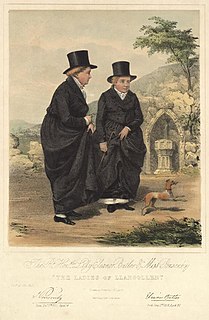
The "Ladies of Llangollen", Eleanor Butler (1739–1829) and Sarah Ponsonby (1755–1831), were two upper-class Irish women whose relationship scandalised and fascinated their contemporaries. The pair moved to a Gothic house in Llangollen, North Wales, in 1780 after leaving Ireland to escape the social pressures of conventional marriages. Over the years, numerous distinguished visitors called upon them. Guests included Shelley, Byron, Wellington and Wordsworth, the latter of whom wrote a sonnet about them.

Llangollen is a town and community, situated on the River Dee, in Denbighshire, Wales. Its riverside location forms the edge of the Berwyn range, and the Dee Valley section of the Clwydian Range and Dee Valley Area of Outstanding Natural Beauty, with the easternmost point of the Dee Valley Way being within the town. It had a population of 3,658 at the 2011 census.

The Llangollen International Musical Eisteddfod is a music festival which takes place every year during the second week of July in Llangollen, North Wales. It is one of several large annual Eisteddfodau in Wales. Singers and dancers from around the world are invited to take part in over 20 competitions followed each evening by concerts on the main stage. Over five thousand singers, dancers and instrumentalists from around 50 countries perform to audiences of more than 50,000 over the 6 days of the event.
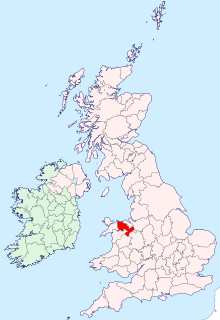
Historic Denbighshire is one of thirteen traditional counties in Wales, a vice-county and a former administrative county, which covers an area in north east Wales. It is a maritime county, bounded to the north by the Irish Sea, to the east by Flintshire, Cheshire and Shropshire, to the south by Montgomeryshire and Merionethshire, and to the west by Caernarfonshire.

The Llangollen Canal is a navigable canal crossing the border between England and Wales. The waterway links Llangollen in Denbighshire, north Wales, with Hurleston in south Cheshire, via the town of Ellesmere, Shropshire. The name, which was coined in the 1980s, is a modern designation for parts of the historic Ellesmere Canal and the Llangollen navigable feeder, both of which became part of the Shropshire Union Canals in 1846.
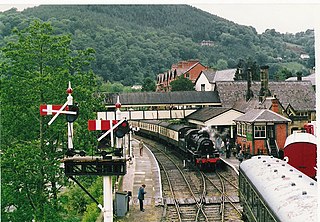
The Llangollen Railway is a volunteer-run heritage railway in Denbighshire, North Wales, which operates between Llangollen and Corwen. The standard gauge line, which is 10 miles (16 km) long, runs on part of the former Ruabon – Barmouth GWR route that closed in 1965. It operates daily services in the summer as well as weekends throughout the winter months, using a variety of mainly ex-GWR steam locomotives as well as several diesel engines and diesel multiple units. A 2+1⁄2 miles (4 km) extension of the railway has been built to complete the line to Corwen. In March 2021 the railway company announced that, having made a loss in three consecutive years, they had invited their bank to appoint receivers.
The Vale of Llangollen Railway was built as a spur from the Shrewsbury and Chester Railway south of Ruabon to the town of Llangollen. The line was built along the northern side of the Dee Valley and authorized by an Act of Parliament on 1 August 1859. It was initially opened for goods only on 1 December 1861 and to passenger traffic on 2 June 1862, and was worked from the outset by the Great Western Railway.
The Llangollen and Corwen Railway was formed as a continuation of the Vale of Llangollen Railway to continue the line along the Dee Valley a further 9 miles 50 chains (15.5 km) to Corwen. This was opened on 1 May 1865 and was worked by the Great Western Railway and subsequently the Western Region of British Railways.
The Ruabon–Barmouth line was a standard-gauge line owned by the Great Western Railway across the north of Wales which connected Ruabon, in the east, with Barmouth on the west coast.
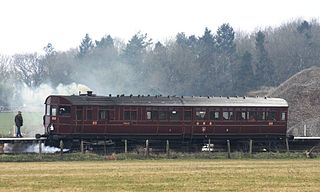
The steam rail motors (SRM) were self-propelled carriages operated by the Great Western Railway in England and Wales from 1903 to 1935. They incorporated a steam locomotive within the body of the carriage.

Froncysyllte, colloquially known as Fron, is a village in Wrexham County Borough, Wales and stands on the banks of the River Dee and the Llangollen Canal. It is situated on the main A5 road which runs from London to Holyhead. It is in the community of Llangollen Rural. The population was 606 as of 2011 UK census.

Plas Newydd is a historic house in the town of Llangollen, Denbighshire, Wales, and was the home of the Ladies of Llangollen, Lady Eleanor Butler and Sarah Ponsonby, for nearly 50 years. Today, it is run as a museum by Denbighshire County Council.
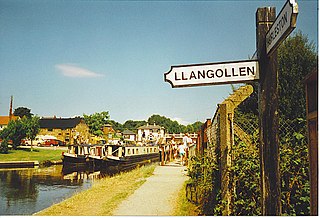
Trevor is a village in Wrexham County Borough, Wales. It is situated in the scenic Vale of Llangollen, on the A539 between Llangollen and Wrexham, in the community of Llangollen Rural, and in the historic county of Denbighshire.

Llangollen Rural is a community and electoral ward in Wrexham County Borough, Wales. It contains the villages of Froncysyllte, Garth, and Trevor, and had a population of 1,999 at the 2001 census, increasing to 2,059 at the 2011 Census. The Pontcysyllte aqueduct is a World Heritage Site. Although named Rural, it is actually densely populated.
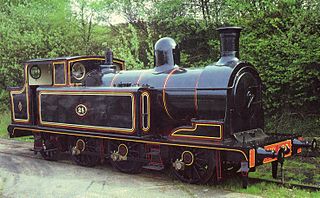
The Taff Vale Railway (TVR) O1 class was a class consisting of fourteen 0-6-2T steam tank locomotives, designed by Tom Hurry Riches, which were introduced to the TVR during the period 1894-1897.
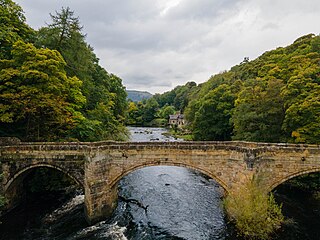
Pont Cysyllte, also known as Cysylltau Bridge or Bont Bridge, is a 17th-century road bridge crossing the River Dee near the village of Trevor, Wrexham County Borough, Wales. It lies 200 m west of Thomas Telford's Pontcysyllte Aqueduct and, carrying the B5434 road, is the main connection between Trevor and nearby Froncysyllte.

The Deeside and Moelfferna quarries were neighbouring slate quarries, near Glyndyfrdwy in North Wales. They were both operated by the same company throughout their history, and were both connected by the Deeside Tramway to the Llangollen and Corwen Railway.
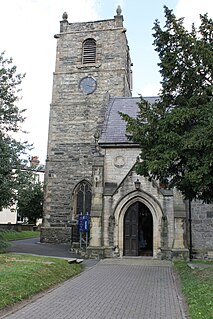
St Collen's Church is a parish church in the town of Llangollen, Denbighshire, Wales. The first church on the site was founded by Collen in the 6th century. Nothing of this building remains. A new church was built in the 13th century, in the Early English Gothic style. This was developed in the succeeding centuries, and then almost completely rebuilt in the 19th century. The architect of the Victorian reconstruction was Samuel Pountney Smith, who retained little of the earlier church, with the exception of the tower. The churchyard contains the grave of the Ladies of Llangollen, Eleanor Charlotte Butler and Sarah Ponsonby, and their servant Mary Carryl, who lived at the nearby Plas Newydd. In November 2021 the first blessing of a gay partnership in a Church in Wales church was held at St Collen's. The church is an active parish church in the Diocese of St Asaph. It is designated by Cadw as a Grade I listed building.

















